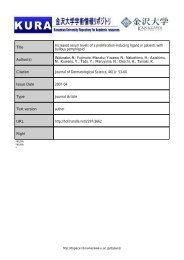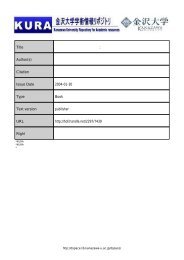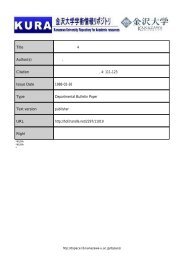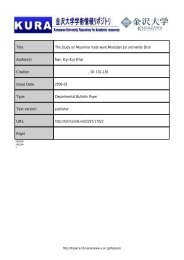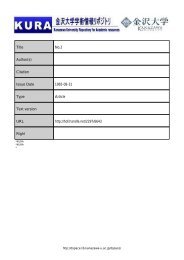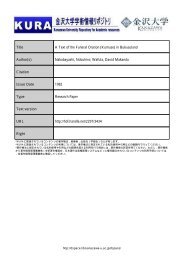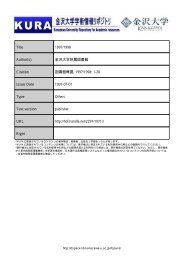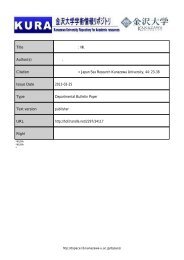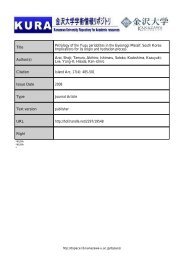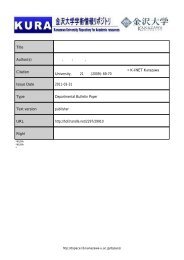Title Petrological feature of spinel lherzolite xenolith from Oki-Dogo ...
Title Petrological feature of spinel lherzolite xenolith from Oki-Dogo ...
Title Petrological feature of spinel lherzolite xenolith from Oki-Dogo ...
Create successful ePaper yourself
Turn your PDF publications into a flip-book with our unique Google optimized e-Paper software.
Blackwell Science, LtdOxford, UK<br />
IARThe Island Arc1038-48712003 Blackwell Science Asia<br />
122June 2003<br />
391<br />
<strong>Oki</strong>-<strong>Dogo</strong> Island <strong>spinel</strong> <strong>lherzolite</strong> <strong>xenolith</strong><br />
N. Abe<br />
et al.<br />
10.1046/j.1038-4871.2003.00391.x<br />
Original Article219232BEES SGML<br />
The Island Arc (2003) 12, 219–232<br />
Thematic Article<br />
<strong>Petrological</strong> <strong>feature</strong> <strong>of</strong> <strong>spinel</strong> <strong>lherzolite</strong> <strong>xenolith</strong> <strong>from</strong> <strong>Oki</strong>-<strong>Dogo</strong> Island:<br />
An implication for variety <strong>of</strong> the upper mantle peridotite beneath<br />
southwestern Japan<br />
NATSUE ABE, 1, * MASAO TAKAMI 2 AND SHOJI ARAI 3<br />
1<br />
ARC National Key Centre Geochemical Evolution and Metallogeny <strong>of</strong> Continents, Department <strong>of</strong> Earth and<br />
Planetary Sciences, Macquarie University, Sydney, NSW 2109, Australia, 2 Department <strong>of</strong> Earth and Planetary<br />
Sciences, Tokyo Institute <strong>of</strong> Technology, 2-15-1 Ookayama, Meguro-ku, Tokyo 152-8551, Japan and 3 Department <strong>of</strong><br />
Earth Sciences, Kanazawa University, Kakuma, Kanazawa 920-1192, Japan<br />
Abstract Spinel <strong>lherzolite</strong> is a minor component <strong>of</strong> the deep-seated <strong>xenolith</strong> suite in the<br />
<strong>Oki</strong>-<strong>Dogo</strong> alkaline basalts, whereas other types <strong>of</strong> ultramafic (e.g. pyroxenite and dunite)<br />
and mafic (e.g. granulite and gabbro) <strong>xenolith</strong>s are abundant. All <strong>spinel</strong> <strong>lherzolite</strong> <strong>xenolith</strong>s<br />
have <strong>spinel</strong> with a low Cr number (Cr#; < 0.26). They are anhydrous and are free <strong>of</strong> modal<br />
metasomatism. Their mineral assemblages and microtextures, combined with the high NiO<br />
content in olivine, suggest that they are <strong>of</strong> residual origin. But the Mg numbers <strong>of</strong> silicate<br />
minerals are lower (e.g. down to Fo 86 ) in some <strong>spinel</strong> <strong>lherzolite</strong>s than in typical upper<br />
mantle residual peridotites. The clinopyroxene in the <strong>spinel</strong> <strong>lherzolite</strong> shows U-shaped<br />
chondrite-normalized rare-earth element (REE) patterns. The abundance <strong>of</strong> Fe-rich<br />
ultramafic and mafic cumulate <strong>xenolith</strong>s in <strong>Oki</strong>-<strong>Dogo</strong> alkali basalts suggests that the later<br />
formation <strong>of</strong> those Fe-rich cumulates <strong>from</strong> alkaline magma was the cause <strong>of</strong> Fe- and light<br />
REE (LREE)-enrichment in residual peridotite. The similar REE patterns are observed<br />
in <strong>spinel</strong> peridotite <strong>xenolith</strong>s <strong>from</strong> Kurose and also in those <strong>from</strong> the South-west Japan arc,<br />
which are non-metasomatized in terms <strong>of</strong> major-element chemistry (e.g. Fo > 89), and are<br />
rarely associated with Fe-rich cumulus mafic and ultramafic <strong>xenolith</strong>s. This indicates that<br />
the LREE-enrichment in mantle rocks has been more prominent and prevalent than Fe<br />
and other major-element enrichment during the metasomatism.<br />
Key words: Fe-enriched peridotite, Japan Sea, LREE enrichment, mantle metasomatism,<br />
<strong>Oki</strong>-<strong>Dogo</strong> Island, <strong>spinel</strong> <strong>lherzolite</strong> <strong>xenolith</strong>s.<br />
INTRODUCTION<br />
Takahashi (1978a) proposed that the upper mantle<br />
beneath the South-west Japan arc is dry and has a<br />
higher geotherm than that beneath the North-east<br />
Japan arc on the basis <strong>of</strong> petrologic studies on the<br />
mafic and ultramafic <strong>xenolith</strong>s <strong>from</strong> <strong>Oki</strong>-<strong>Dogo</strong><br />
Island, southwestern Japan and Megata volcano,<br />
north-eastern Japan. Recent studies on mantle<br />
*Correspondence: Deep Sea Research Department, Japan Marine Science<br />
and Technology Center, 2-15 Natsushima-cho, Yokosuka 237-0061, Japan<br />
(email: abenatsu@jamstec.go.jp).<br />
Received 3 June 2002; accepted for publication 9 January 2003.<br />
© 2003 Blackwell Publishing Asia Pty Ltd.<br />
<strong>xenolith</strong>s <strong>from</strong> many other localities in the Japan<br />
arcs are consistent with this conclusion (Abe 1997;<br />
Arai et al. 1998, 2000). Arai et al. (1998, 2000)<br />
proposed that the variety <strong>of</strong> mantle peridotite<br />
beneath the South-west Japan arc depends on the<br />
variety <strong>of</strong> the degree <strong>of</strong> metasomatism by Fe-rich<br />
melts superimposed on the primary residual<br />
characteristics.<br />
<strong>Oki</strong>-<strong>Dogo</strong> Island is very important for the <strong>xenolith</strong><br />
study because it is the most continent-ward<br />
locality <strong>of</strong> the mantle peridotite <strong>xenolith</strong>s in the<br />
South-west Japan arc, approximately 60 km <strong>of</strong>f<br />
shore <strong>of</strong> the Honshu Island (Fig. 1). Large<br />
amounts <strong>of</strong> mafic and ultramafic <strong>xenolith</strong>s including<br />
the residual mantle peridotite have been




